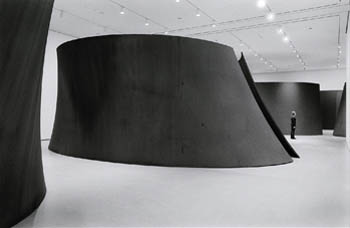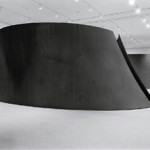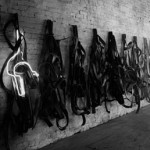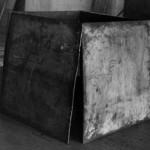By JOHN RUGGIERI
I remember the big stink, the uproar, that spilled into the daily newspaper when Serra’s Tilted Arc was deemed unfit, too big, just not practical enough, for human consumption in its commissioned site at the Federal Plaza in New York and was later destroyed. Serra was painted as a diva, as his 120-foot steel sculpture that he specifically made for the site, attracted the ire of a judge and Federal workers for dividing the Plaza in half. Despite Serra’s impassioned pleas and the overwhelming support of artists, museum curators, and art critics it was carted off to a scrap-metal yard.
It was a paradigm that became a gathering storm for public disdain of all things modern and sensational. In later years we had the Mapplethorpe crisis of taste, which raised important questions about displaying sexual images in the privacy of the public museum. Eventually, we seem to have a separate but equal playing field, where the art world (and nearly all media forms) uses controversy, as in the slyly titled exhibition Sensation: Young British Artists from the Saatchi Collection.
I am heart-warmed by seeing Serra’s retrospective pull in huge crowds, especially after seeing the show. Minimalism today is alive and well, sometimes fluffed up for those seeking a higher social echelon and also available at your local Target.
Minimalism in Serra’s smaller sculptures is heavy with hidden meaning that I had no idea existed before I relented and used the museum audio guide, which I usually pass up as a touristy crutch. Serra’s own warm, intelligent and relaxed voice in my head was helpful in understanding the subtle play of ideas of balance, perception, engineering, and aesthetics that you couldn’t really “see” otherwise in his industrial works.
He isolates smallish ideas, words, and phrases and interprets them into massive, heavy forms. Belts, inspired by the forms in Pollock’s work, is a collection of wall-hung twisted strips of rubber, not too far from resembling a line-up of flat bicycle tires found on the highway, with one accented by a slinky line of neon light. “I see the world as a kind of drawing.” explains the artist, mining found and custom-made materials alike.
I have been a soldier for public art and education as founder and creative director of the nonprofit organization Abstraction Made Elementary, which brought abstract art to young, urban children and exhibited their best works. I will often gauge how children react or might react to a contemporary exhibition, and I can imagine the wonderfully simple lessons on building and architecture Serra could teach to second-graders in this exhibition. His very precise sculptures of precariously supported planes and tubes of lead and steel, and how they are governed by gravity and subtle placement, make for timely educational tools for the young and old.
Minimalism is fun here in playrooms of steel and rubber, hanging from the wall, up on the ceiling, down on the floor. The sheer act of being under Delineator, several tons of steel slab hung on the ceiling, and being able to walk on its big twin slab on the floor, was liberating. One large room is a jungle gym of right angles, balancing acts of dark steel against museum white walls, seemingly tenuous and quietly ambitious. The subjects inherent in floor works such as One Ton Prop (House of Cards) are relevant now as we live more aware of our fragile infrastructure – bridges falling down, bombs and nature leveling whole communities, Twin Towers toppled. A Buddhist workshop on the impermanence at the heart of life could be offered to all ages.
Serra’s own humanitarian concern finds heavy-metal form in the extremely minimalist Equal-Parallel: Guernica-Bengasi, which not only toys with our visual perceptions of how things appear higher/lower/larger/smaller/closer/farther but also memorialize, without a word or a plaque, those killed during war.
His largest works need significant space for full effect. His high-walled sculptures inside the museum, Band, Sequence, and Torqued Torus Inversion, were specifically created for the second-floor exhibition space by Serra in 2006 and were set upon concrete flooring and stuffed in exhibition rooms too small to allow these curvaceous sculpture-rooms breathing room. The proportions of his large-scale works depend on what is and what is not around them, namely white museum walls that gift-box and enclose the sculpture and track lighting that can barely dribble their tiny beams on the massive steel planes.
___
My near-blank and rather claustrophobic experience of these behemoths indoors paled to experiencing his massive works installed outside in The Abby Aldrich Rockefeller Sculpture Garden.
In my trek to MOMA for the big Serra retrospective, I had walked on Fifth Avenue upstream alongside the tourist-laden, amplified route of the annual gay pride march. I admit it was a bit of a relief to get inside the civilized confines of MOMA’s big white walls and, toward the end of my Serra sojourn, I ended up in the in the garden walking in and around Intersection II and Torqued Ellipse IV. Serra’s rusty-metal steel slab arches slithered and sliced through the garden, anchored elegantly on white marble walkways, amidst lounging visitors and outdoor café-goers.
The parallel curved planes acted as an aural satellite dish, absorbing and echoing the thump-thump beat on the street into the metaphoric heart of the sculpture.
I continually peeked through the garden walls onto West Fifty-fourth Street to watch the raucous rainbow of color and flesh of the most bizarrely and least-dressed marchers, the near-perfect opposite of the minimalist haven created by Serra’s large-scale works in the garden. They were lined up and awaiting their entrance onto the packed main route on Fifth Avenue, assigned the rear of the parade while gay community churches enjoyed the mainstream front and center of the parade hours before.
They were over-dressed in pink and purple feather outfits that recalled The Philadelphia Mummers; the least costumed were barely clad in leather G-strings. The die-hard minimalists in the parade were a contingent of naturalists festooned with small signs, strung around their hips and covering their privates, petitioning for rights tested there, all grassroots on pavement.
The boundaries between art and life were blurred as I continually peeked through the garden walls onto the street, enjoying the blasting House music, then back to my reverie in Serra, each strangely refreshing the other for me. I am almost sure that other pastoral patrons were not as amused as I was, as Serra’s sedate work easily can be seen to compete with such louder, public spectacles as a pride march.
Outside in the garden I felt Serra’s work even bigger as part of the New York landscape on high volume in waning daylight. His swerving forms, dramatic yet dwarfed by looming buildings above, were given private dancing room in the open air, barraged by a crowded skyline of diverse moments in the history of twentieth century architecture.
I could enjoy his large works so much more outside – the air and light revealing the multi-hued tone and texture of the not-yet-rusted “mill scale” surface of Intersection II – like the most committed and hydrated tourist who stayed on the hot sidelines for hours watching gay revelers splay yet one more bright color of the rainbow. We as spectators were vicariously free and awed by those who dare to express themselves in the studio and in the streets.
The public in public art is one besieged by the flash, dash, and crash of imagery in our multimediated life. It is more familiar and perhaps easier to be entertained by the TV-like spectacle of a gay pride parade (or a funky 60s exhibition) than to spend an afternoon “reading” meaning into Serra’s bent metal. Still, both minimalism and homosexuality were avant-garde statements about thirty years ago. Today I am an insider on both fronts. To see as many average New Yorkers and out-of-towners per capita inside the quiet Serra retrospective and outside in the din of a gay parade was a sweet reckoning of how time heals many, if not all, wounds, artistic and political.
The two “styles” co-exist as survivors, seasoned warriors of change, commanding larger and larger crowds, just yards away from each other. The message that radical difference, innovation, and even strangeness are sometimes greater goods may not become crystal clear for either audience. But the mediums of a major museum retrospective and an annual, city-sanctioned, Fifth Avenue parade give mainstream cred, respectively and respectfully, to minority rights and artistic expression not fully understood or accepted by the mainstream.
“I don't think it is the function of art to be pleasing,” Serra said at the time of Tilted Arc’s demise. “Art is not democratic. It is not for the people.” The art in public art can be as exciting as the very avant-garde yet pleasing Millenium Park in Chicago and as average and literal as The Boston Irish Famine Memorial in downtown Boston outside Borders, often the bombing target of highly digestive pigeons.
Boasting Anish Kapoor's hugely popular Cloud Gate sculpture; the interactive Crown Fountain by Jaume Plensa; and Frank Gehry-designed Jay Pritzker Pavilion, Millennium Park is a hit in that Midwestern city, similar to the top-ten popularity of Serra’s retrospective. What is “hip and historic” about Boston needs to be aggressively exploited so that not only temporary but permanent public art be given full creative reign and yet somehow answer to the multitude as a good spectacle should.
With the zest of seeing these exhibitions fueling my defiance, I’d happily go back in time and stand in the way of the officials, and cranes, that removed Serra’s slab of steel from its home in the outdoors.
- Richard Serra, Torqued Torus Inversion, two torqued toruses weatherproof steel, 2006, collection of the artist.
- Richard Serra, Belts, Vulcanized rubber and neon tubing, 1966-67, Solomon R. Guggenheim Museum, New York.
- Richard Serra, One Ton Prop (House Of Cards, Lead antimony, four plates, 1969, The Museum of Modern Art, New York.
"Richard Serra Sculpture: Forty Years" is on view until September 10th at insert at the Museum of Modern Art, located at 11 West 53 St. in Manhattan.
All images are courtesy of the artist and the Museum of Modern Art.







